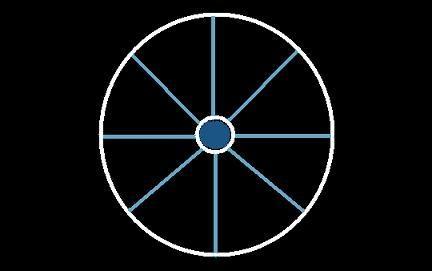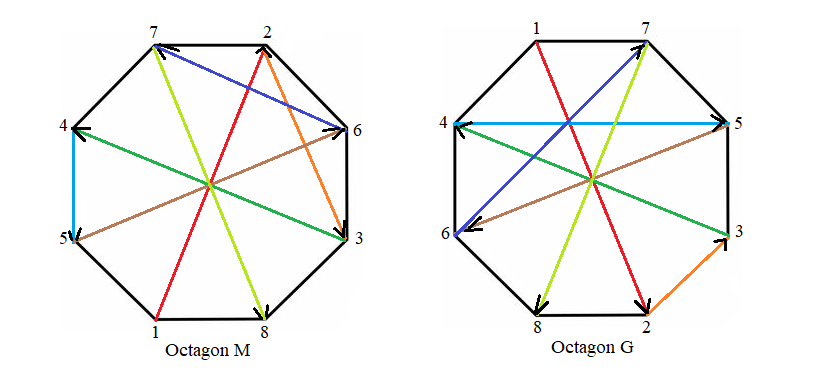Octagon Algorithm for Partial Border Wheel Squares (Part XIV)
The Eight Node Way - (a,c,e) Squares
The previous section Part XIII looked at (a,d,f) type squares specifically the 9×9 squares where the initial, central cell number was one and the Octagon I and L algorithms were used for filling in the non spoke cells. Part XIV is concerned with the generation of partial border squares where only the internal 3×3 and the outer squares are magic. Both 5×5 and 7×7 squares will be constructed. Since the 5×5 is composed of only an internal 3×3 and the outer 5×5 the square is fully bordered.
For the square to be partially or fully bordered the internal 3×3 square is constructed using a triplet of three numbers to ensure that all the rows columns and diagonals sum to the magic sum 39 for the 5th order. These triplets are labeled as (c,d,r) corresponding to the last cells in the central, diagonal and row spokes adjacent to the center cell in the square and are shown in Table Ia. Those triplets in white correspond to triplets that contain at least one common number with any of the spokes of the wheel:
Table Ia
| Even c |
2,3,4 |
| 4,5,6 |
| 6,7,8 |
| 8,9,10 |
The 5×5 Wheel Squares
This section will deal with numbers (after the main diagonal is filled) that run in the order a (top center), c (bottom right) and e (left center) and whose 3×3 inner squares are filled with either of the three triplets in Table Ia. The addition of triplet numbers to the spokes follows the difference (Δ) in order 3, 5 or 7 when the initial a= 1, a Δ of 3 or 5 when the initial a= 3 and a Δ of 3 when the initial a=5 (see Border squares 5a, 5b and 5c below). Only those triplets are used that have no common numbers in the spokes.
The wheel portion of the square is filled according to Part X, using the blue color values from Table Ia to ensure that every row, column and diagonal of the internal 3×3 square adds up to the magic sum of 39. The construction of the square is then completed by the use the M and G algorithms, using graph theory, as was done previously in Part X.
Constructing 5th order squares is to simply fill the non spoke portions of the squares using the Octagon G algorithm. Below are shown the six consecutive 5th order squares covering all three of the blue triples of Table Ia:
Border 5a(4,5,6)g
| 24 | 7 |
1 | 18 |
15 |
| 10 | 21 |
4 | 14 |
16 |
| 3 | 6 |
13 | 20 |
23 |
| 17 | 12 |
22 | 5 |
9 |
| 11 | 19 |
25 | 8 |
2 |
|
|
Border 5a(6,7,8)g
| 24 | 4 |
1 | 21 |
15 |
| 10 | 19 |
6 | 14 |
16 |
| 3 | 8 |
13 | 18 |
23 |
| 17 | 12 |
19 | 7 |
9 |
| 11 | 22 |
25 | 5 |
2 |
|
|
Border 5a(8,9,10)g
| 24 | 4 |
1 | 21 |
15 |
| 7 | 17 |
8 | 14 |
19 |
| 3 | 10 |
13 | 16 |
23 |
| 20 | 12 |
18 | 9 |
6 |
| 11 | 22 |
25 | 5 |
2 |
|
Border 5b(6,7,8)g
| 22 | 1 |
3 | 24 |
15 |
| 10 | 19 |
6 | 14 |
16 |
| 5 | 8 |
13 | 18 |
21 |
| 17 | 12 |
20 | 7 |
9 |
| 11 | 25 |
28 | 2 |
4 |
|
|
Border 5b(8,9,10)g
| 22 | 1 |
3 | 24 |
15 |
| 7 | 17 |
8 | 14 |
19 |
| 5 | 10 |
13 | 16 |
21 |
| 20 | 12 |
18 | 9 |
6 |
| 11 | 25 |
23 | 2 |
4 |
|
|
Border 5c(8,9,10)g
| 20 | 1 |
5 | 24 |
15 |
| 4 | 17 |
8 | 14 |
22 |
| 7 | 10 |
13 | 16 |
19 |
| 23 | 12 |
18 | 9 |
3 |
| 11 | 25 |
21 | 2 |
6 |
|
This completes the Octagon M and G method. Go to Part XV.
Go back to Part XIII. Go back to homepage.
Copyright © 2022 by Eddie N Gutierrez. E-Mail: enaguti1949@gmail.com


